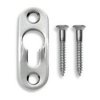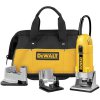Thinking it was a good idea, I purchased a dozen or so of these metal keyhole hangers a few years ago. Now that I'm preparing to use them, I have a question. Should they be inset into the wood? If so, does there have to be a second offset behind the place to let the screw head fit? If I mount one on the surface of a board, I can't find a screw that will fit into the hanger.




